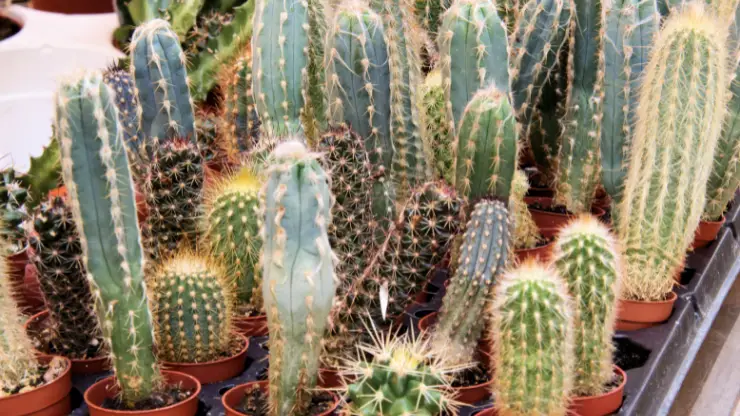
If you have a south-facing window that gets strong sunlight for at least 4 hours a day, you can successfully grow most types of cacti indoors. Many types don’t need much water and tolerate dry indoor air well. But there are some care-related issues that cause problems like browning.
Why is my cactus turning brown? Overwatering is the most common reason for browning. But sunburn, fungi, underwatering, and too little fertilizer can also cause your cactus to turn brown. Let’s take a closer look at how you can diagnose and fix these issues in your plants.
Overwatering and Root Rot
If the base of your cactus near the soil turns brown or black, this indicates root rot due to overwatering and/or poor air circulation. The rot will spread from the roots to the body of the plant and eventually kill it completely.
If your cactus is only in the beginning stages of root rot, it may be possible to save it. Scrape the black portions of the plant away using a small serrated knife. Then allow the callus to heal before watering again. If the damage is severe, you may need to propagate a new plant from cuttings.

To prevent root rot from occurring, avoid overwatering during winter, when most cacti and succulents are at rest. In winter, only spritz lightly with a spray bottle or just dribble a bit of water onto the surface of the soil from the tip of a squirt bottle.
Water more often in spring and summer while plants are actively growing. In general, it’s better to water cacti lightly and frequently rather than giving them a lot of water at once. But always check the care requirements for your particular cactus variety to see its specific needs.
Additionally, make sure your pot has drainage holes and is not standing in water. You’ll also need to use a well-draining potting soil amended with sand (or that’s specifically formulated for cacti and succulents). Poor drainage can lead to standing water and eventually – root rot.
Sunburn (Too Much Sunlight)
If you see brownish to gray patches appear on the leaves of your cactus, this is typically an indication of sunburn. This can be caused by too much sunlight. But it’s more likely that it wasn’t acclimated to a sunnier location quickly enough.

When you move a cactus from a shadier spot to a sunnier spot – for example, from an east- or west-facing window to a south-facing window – it can become sunburned if you move it too quickly. Acclimate the plant slowly by gradually exposing it to increasing amounts of sunlight.
Most types of cacti – with the exception of epiphytic or rain forest types – thrive in as much bright sunlight as possible. However, they may still sunburn if moved too quickly into high light when they aren’t used to it yet.
Corking & Fungal Infection
Round and/or angular brown spots or patches that form on your cactus and steadily increase in number indicate corking, which can be caused by fungi. Corking usually occurs following a bruise or other physical injury to the plant’s tissue.
These brown spots will eventually raise to form scabs. While they don’t damage the plant any further, they can be unattractive. High humidity, poor air circulation, overwatering and in some cases, over fertilizing, can also contribute to the problem.
To help cacti with corky scab, increase air circulation around affected plants, reduce humidity if possible, reduce watering and feeding, and make sure you’re fertilizing according to the specific plant’s requirements – not more often.
Underwatering (Too Little Water)
Cacti are well adapted to dry, arid environments. However, that doesn’t mean they can’t suffer from a lack of water. An under-watered cactus will first turn yellow and become shriveled, and if you don’t fix the problem it will eventually turn brown.

Underwatering your cactus can also cause poor growth (or no growth at all) and bud drop in epiphytic varieties. If you suspect your cactus is turning brown due to too little water, follow these instructions to bring it back to life:
- Place the entire pot in a shallow dish of water. This is known as bottom-watering. It will gradually moisten the soil without water-logging.
- Leave the cactus in the water until the top of the soil begins to glisten with water. This can take several minutes to several hours, but don’t leave it too long!
- Once you notice water on the surface, remove the pot and allow it to drain.
Your cactus should plump up quickly after this process. If you lost buds, however, they will most likely not regenerate until the next year.
I also have a post on How to Revive Under Watered Plants in 5 Easy Steps if you think this might be your problem. And if you just aren’t sure, check out this post: How to Tell if a Plant is Overwatered or Underwatered.
Under Feeding (Too Little Fertilizer)
Although less likely to be the culprit than the other reasons on this list, under-feeding can still cause your cactus to turn brown. If you notice pale or yellowing plants that don’t grow much and don’t flower, then lack of nutrients is probably to blame. This can eventually cause browning in some types of cacti, too.
Make sure your cactus is watered adequately, as the roots can’t absorb nutrients from dry soil. In fact, your browning problems could be caused by a combination of underwatering and underfeeding (or lack of absorption caused by underwatering).
Feed your cactus as recommended in its specific care guide. In general, cacti and succulents are slow-growers that don’t need much nitrogen. They typically require feeding only during periods of active growth with a special 2-7-7 cactus fertilizer.
Why is My Cactus Turning Brown?
Primary factors that cause browning in cacti include overwatering, too much sunlight or not acclimating to a sunnier location, corky scab due to some types of fungi and/or physical injury, underwatering, and too little fertilizer.
In most cases, the problem is related to watering too often. This is a common cause of browning – especially with new cactus owners. It’s always better to water too little rather than too much, as most cacti can bounce back from underwatering. But overwatering will quickly kill them.
How Do You Save a Browning Cactus?
How to save a browning cactus depends on the reason it’s turning brown. If the cause is overwatering, follow these instructions on how to save a cactus rotting from the bottom:
- Scrape the black portions of the plant away using a small serrated knife.
- Remove the plant from its pot and place it on some newspaper or paper towels on a dry surface. Leave it overnight to dry.
- Once the roots are dry, use sterilized scissors or pruning shears to cut away any roots that are black and rotten.
- Re-pot the plant in fresh, well-draining potting soil in a container with drainage holes.
- Do not water again for a week after re-potting. Always allow the surface of the soil to dry out between watering and keep your cacti relatively dry during dormancy in winter.
If the cause is sunburn, move your plant to a shadier location and acclimate slowly to higher light levels. If the cause is corky scab, increase air circulation, reduce watering, and don’t overfeed. If the cause is under feeding, check your cactus’ care guide to make sure you’re feeding enough.
Related Questions
Here are some frequently asked questions regarding cactus plants turning brown that you might find helpful (plus my answers to them).
What Does a Dying Cactus Look Like?
A dying cactus will look shriveled, yellowing, or brown. It may drop leaves and/or buds, produce little or no growth, and just generally look unwell. Discoloration such as yellowing or browning is a sure sign that the plant is in distress.
Can You Bring a Brown Cactus Back to Life?
Yes, you can bring a brown cactus back to life if you know what’s causing the browning – and as long as the plant isn’t too far gone. If your cactus is completely brown and dead, it may be too late to save it. If there are still some signs of life, even just a little, you can usually save the plant.
How Do You Know if You’re Overwatering Your Cactus?
An overwatered cactus will turn soft and yellow, and eventually start to rot. You may notice the plant turning brown or even black at the base near the soil. Too much water can also split the outer skins of some types of cacti, leaving brown scars.
If the soil is kept consistently wet, your cactus will eventually develop root rot, which can spread to the rest of the plant. Make sure to water lightly and frequently during spring and summer, allowing the soil to dry out between waterings. Reduce watering in the winter to prevent rotting.
If you think your cactus is overwatered, check out my post on How To Fix Overwatered Plants (5 Critical Steps).




